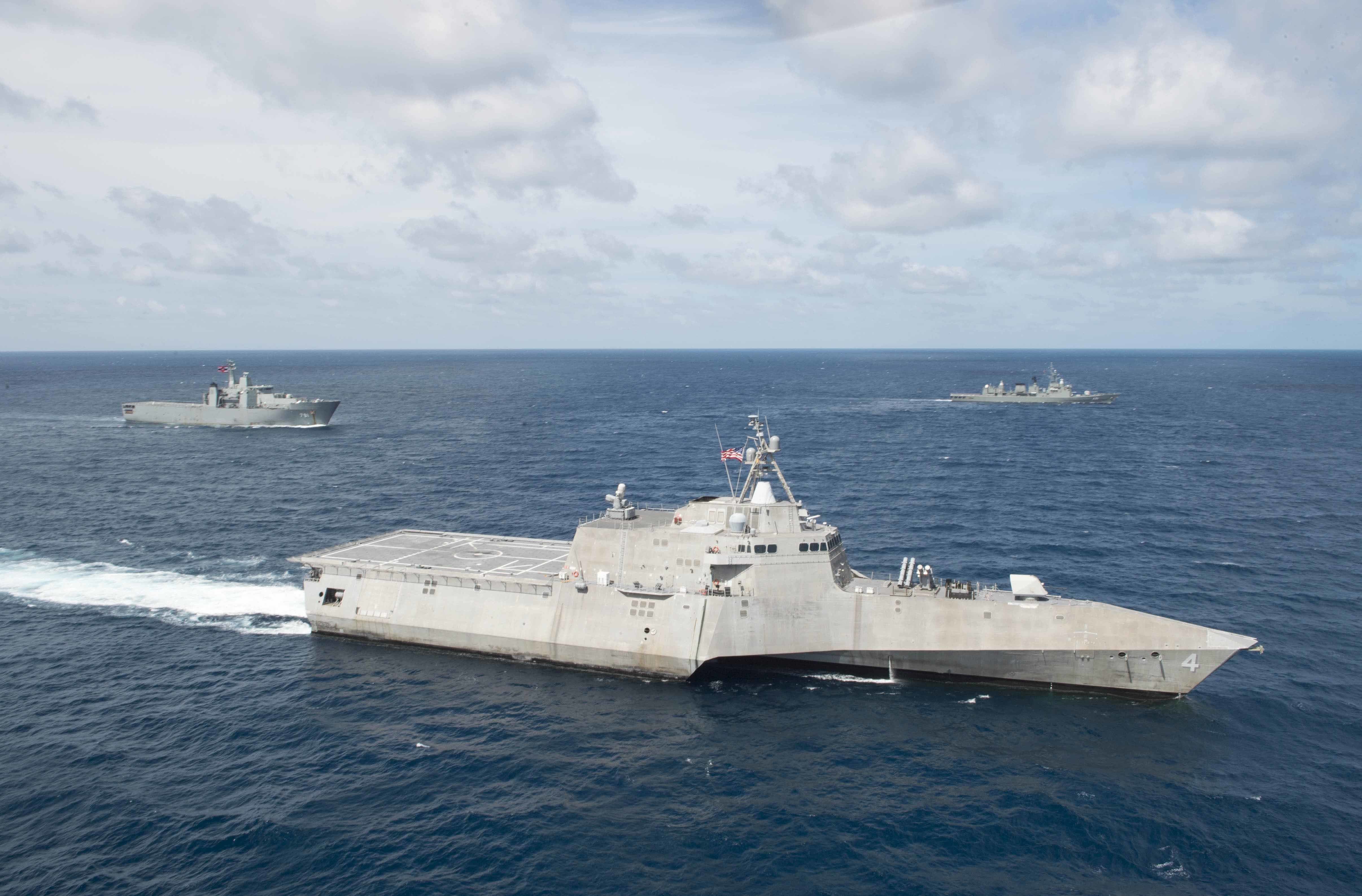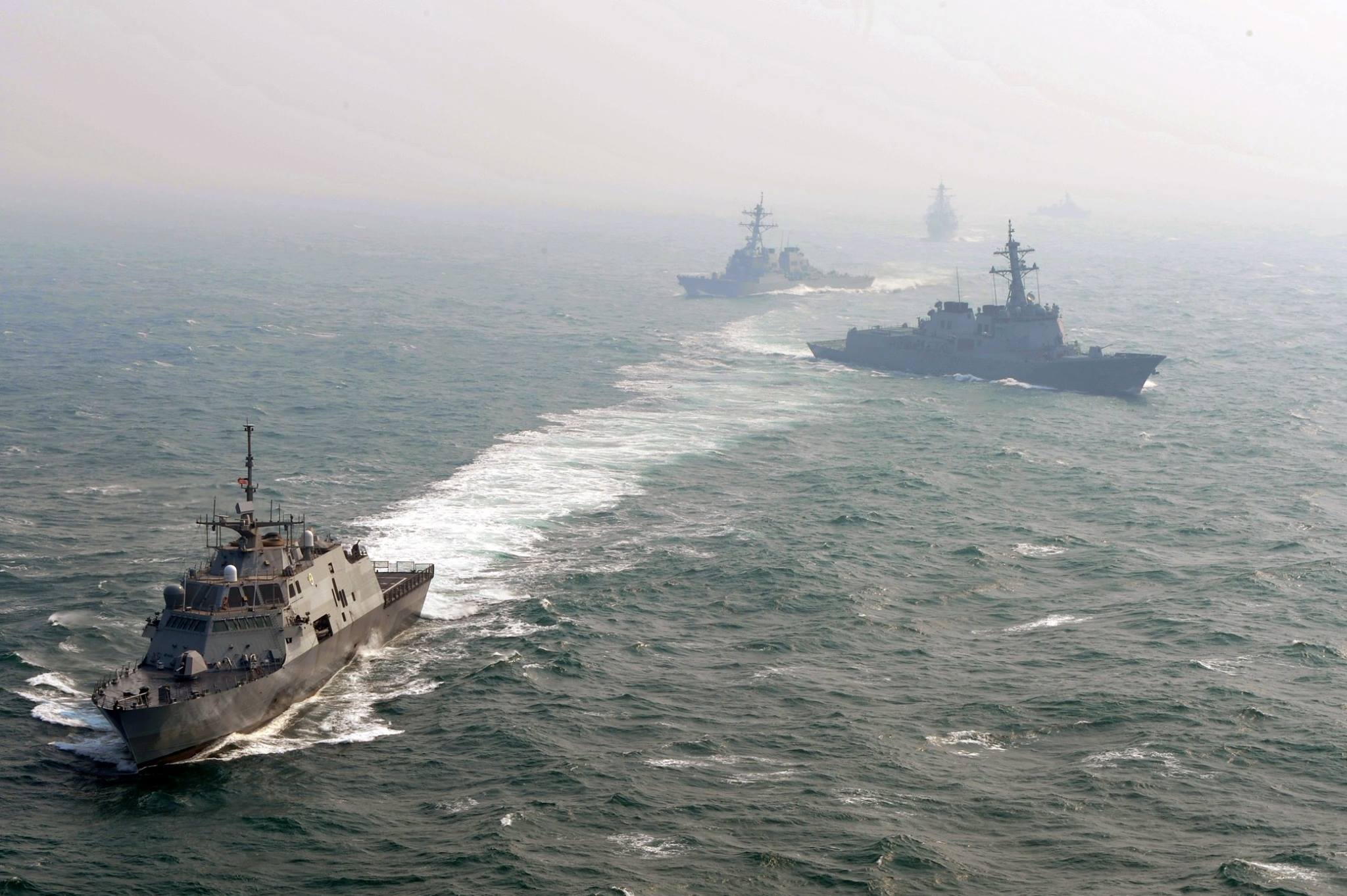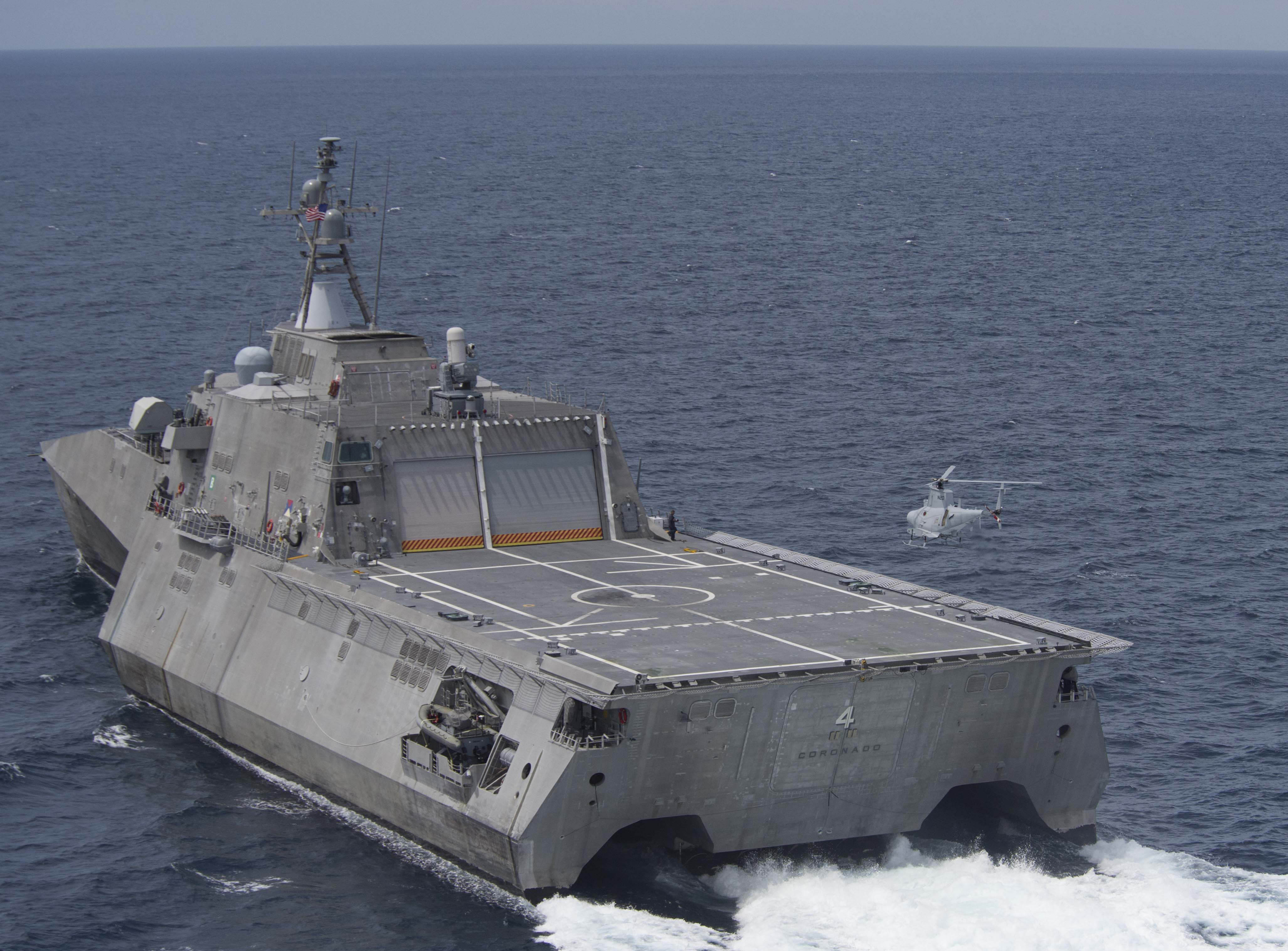
WASHINGTON NAVY YARD – The Navy is laying the groundwork now for more complex Littoral Combat Ship operations in Asia and the Middle East, preparing to deploy two simultaneously to Singapore and one to Bahrain in 2018, the program executive officer for LCS told USNI News.
The service has deployed three LCSs overseas so far, all one at a time to Singapore: the Lockheed Martin-built USS Freedom (LCS-1) and USS Fort Worth (LCS-3), and the Austal USA-built USS Coronado (LCS-4). Rear Adm. John Neagley said the PEO and operators have been collecting as many lessons learned as they can during these deployments in the hopes of feeding that information back into maintenance models and logistics assumptions the manning and training pipelines and plans to backfit the ships with upgrades.
In his first formal interview since assuming command last summer, Neagley told USNI News that these lessons learned will all come into play next year when the Navy ups the difficulty of its LCS operations – with two Independence-variant ships operating concurrently out of Singapore, and one Freedom-variant ship operating out of Bahrain for the first time in the program’s history.
“I think it’s going to be really powerful to have two ships operating together, so you kind of get the synergy of two platforms operating together, doing dual operations, and you get the benefits of having those two crews on station doing that work,” he said.
“And everything we’ve learned to date, we’re certainly going to carry forward for ’18. Bahrain will be new for us, it’ll be the first time we operate a ship out of Bahrain, so we’re doing some preparations now to make sure we’re ready to go do that and we have the footprint established. We have a facility out there we share with FDRMC, which is the Forward Deployed Regional Maintenance Center, those are the guys who do maintenance for our ships out there … so we share that facility and there’s some good synergy between those two groups as we operate out of that part of the world.”
Neagley would not speculate on how the U.S. 5th Fleet commander would choose to operate the ship in theater, but he said having a shallow-draft surface combatant in the Middle East would open up a lot of opportunities to the operational commanders.
“I did a lot of operations in that part of the world, and I’ll tell you, having a shallow-draft ship to operate up in the Persian Gulf and some of those areas is a big asset. I had a DDG, and every time I went up north and had to operate around the oil wells up there, you had to be on your toes and watch the draft of that ship,” Neagley said, referring to commanding guided-missile destroyer USS Fitzgerald (DDG-62) when Operation Iraqi Freedom began in 2003.
“But having a 15-foot draft ship, being able to do those kinds of operations I think provides us a lot of flexibility.”
Neagley said the same of LCS operations in the Pacific, adding that “for that part of the world they’re a really good size ship to operate with our partners out there. The ability to kind of engage with Brunei and the other countries in that particular area with that size of ship, and to be able to go into ports that we haven’t really been able to go into before because we have a relatively shallow draft, we’re talking about a 15-foot draft, has opened up some things for us.”

While he said both variants meet the same requirements from an acquisition perspective, he is pleased with the strengths the Freedom-variant will to the Middle East and the Independence-variant to the Pacific during next year’s deployments.
“Some have attributes that give them some comparative advantages – certainly the flight decks on the LCS-2 variant lend themselves to a lot of good helicopters operations and those kinds of things. The stern ramp on the Freedom variant, being able to launch and recover 11-meter [rigid-hull inflatable boats] quickly, there’s advantages to that. … I think you could put either ship either place and it would do great, but I think we’ll leverage the capabilities of those ships appropriately for the missions that the fleet commander has out there.”
While lessons learned so far will shape these deployments next year, the Navy is certainly not done learning about these ships. Setting up a new maintenance hub in Bahrain, as well as trying to simultaneously maintain two Independent-variant ships, for which the Navy has less operational data than the Freedom-variant, will stress the Navy’s maintenance and logistics communities, which have already had to grapple with forward-stationing essentially two distinct types of ships. The Freedom- and Independence-variants use different combat systems, different propulsion, and so on, which means the Navy has to have the right parts and people stationed at the right place at the right time for ship repairs on both variants, or else the LCS is sidelined for too long during maintenance and misses operational assignments. Neagley said the time it takes to turn around a forward-deployed LCS for maintenance has steadily decreased, from the Freedom deployment to Fort Worth to Coronado, so “there’s some really good trends there.”
He added the Navy has a pretty good idea of what it takes to keep the Freedom-variant running on deployment, with two deployments under its belt, and is learning on the Indy-variant as it collects more data during the ongoing deployment, which began last summer.
“Is there a part where we see a usage rate that’s higher while forward-deployed than back here in CONUS that we have to have that piece there? Is there a part that we know would have a particularly long lead time that we should think ahead and put it out there? Those are the kinds of things we’re learned,” the admiral said.
“And we’ve really cut the response time down on Coronado based on lessons learned. Now we have better coordination with [original equipment manufacturers] that might go out and help with some of that repair, we have better coordination with the types of parts that we might need, and that you just get from operating – that’s experience-based learning, and the ship’s doing that real time, and it’s showing its benefit in our ability to turn a ship around for a maintenance period and continue to do operations.”
Neagley said, “quick learning” is the common thread with all that PEO LCS is trying to do right now. While some critics of the program have noted that Freedom and eventually Fort Worth were sidelined during their deployments with major maintenance issues, Neagley said the Navy made a conscious decision to put the ships out on deployment as soon as it could to begin capturing lessons learned that would inform concepts of operations, material fixes to send back to the shipyards’ production lines, and training plans for the crews.

One big win that came from that is the fleet’s identification of the need for an over-the-horizon missile.
“That’s a significant capability for the ship. When you look at competitors in that part of the world, you have to pay attention to where you have a missile, or a ship with that kind of capability, and it kind of changes that dynamic a little bit. It provides a little bit more stick, offensive stick for that ship. So I think that’s certainly something we value over there,” he said.
Other bits of fleet feedback have led to a list of lethality and survivability upgrades that the Navy would like to backfit into LCS ships as early as 2018, in an effort to increase the LCSs’ capability to something closer to the future frigate’s level of lethality and survivability. The Navy’s 2018 unfunded priorities list includes a mention of $84 million for four ship-sets of upgrades, which include four key items: space and weight for the over-the-horizon missile, increased magazine protection, anti-submarine warfare lightweight tow embark, and hardening of chilled water to support the SeaRAM anti-ship missile defense system already installed on the ships.
Neagley called these upgrades “relatively easy to do, doesn’t require major design changes to the ship, but based on those lessons learned from the first four ships we said, hey, these are the kinds of things that came out of the work we had done on the frigate program” and could be backfitted onto LCSs.
Neagley said he’s ready to do the upgrades as soon as the funding becomes available.
“For us it’s driven by funding at this point. They’re on the unfunded list. But the good news is we have the drawings, the plans, we know how to do it, so this is not a hard thing for us to go do,” he said.
“We’ve identified those as things that we think would be important to improve the ships in the near-term. And we’ll continue to look at those kinds of things, and I think operating forward does help us identify that kind of stuff.”





